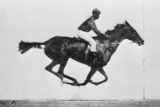In 1872, former Governor of California Leland Stanford, a businessman and race-horse owner, had taken a position on a popularly-debated question of the day: whether all four of a horse's hooves are off the ground at the same time during the trot. Up until this time, most paintings of horses at full gallop showed the front legs extended forward and the hind legs extended to the rear. Stanford sided with this assertion, called "unsupported transit", and took it upon himself to prove it scientifically. Stanford sought out Muybridge and hired him to settle the question. In later studies Muybridge used a series of large cameras that used glass plates placed in a line, each one being triggered by a thread as the horse passed. Later a clockwork device was used. The images were copied in the form of silhouettes onto a disc and viewed in a machine called a Zoopraxiscope. This in fact became an intermediate stage towards motion pictures or cinematography.
In 1877, Muybridge settled Stanford's question with a single photographic negative showing Stanford's Standardbred trotting horse Occident airborne at the trot. This negative was lost, but it survives through woodcuts made at the time. By 1878, spurred on by Stanford to expand the experiment, Muybridge had successfully photographed a horse in fast motion
Another series of photos taken at the Palo Alto Stock Farm in Stanford, California, is called Sallie Gardner at a Gallop or The Horse in Motion, and shows that the hooves do all leave the ground — although not with the legs fully extended forward and back, as contemporary illustrators tended to imagine, but rather at the moment when all the hooves are tucked under the horse as it switches from "pulling" with the front legs to "pushing" with the back legs. This series of photos stands as one of the earliest forms of videography.
In 1877, Muybridge settled Stanford's question with a single photographic negative showing Stanford's Standardbred trotting horse Occident airborne at the trot. This negative was lost, but it survives through woodcuts made at the time. By 1878, spurred on by Stanford to expand the experiment, Muybridge had successfully photographed a horse in fast motion
Another series of photos taken at the Palo Alto Stock Farm in Stanford, California, is called Sallie Gardner at a Gallop or The Horse in Motion, and shows that the hooves do all leave the ground — although not with the legs fully extended forward and back, as contemporary illustrators tended to imagine, but rather at the moment when all the hooves are tucked under the horse as it switches from "pulling" with the front legs to "pushing" with the back legs. This series of photos stands as one of the earliest forms of videography.


No comments:
Post a Comment